MIST
Magnetosphere, Ionosphere and Solar-Terrestrial
Nuggets of MIST science, summarising recent papers from the UK MIST community in a bitesize format.
If you would like to submit a nugget, please fill in the following form: https://forms.gle/Pn3mL73kHLn4VEZ66 and we will arrange a slot for you in the schedule. Nuggets should be 100–300 words long and include a figure/animation. Please get in touch!
If you have any issues with the form, please contact This email address is being protected from spambots. You need JavaScript enabled to view it..
Energetic Proton Losses Reveal Io's Extended and Longitudinally Asymmetrical Atmosphere
By Hans Huybrighs (Dublin Institute for Advanced Studies)
Io is a moon of Jupiter with active volcanoes and an atmosphere of which the structure and variability is poorly understood. A fascinating object on its own, neutral gas from Io also serves as the main source of plasma in Jupiter's magnetosphere. Improving our understanding of Io's atmosphere will allow us to better understand the precise link between Io's neutral environment and the plasma torus surrounding Jupiter. In this work we analyse data from the historic Galileo spacecraft that encountered Io. Specifically, we analyse regions close to Io where losses of energetic protons occur.
Using a comparison between the Galileo data and particle tracing model we find that charge exchange between the protons and Io's atmosphere along with the effect of the electric and magnetic fields can cause the measured decreases. We show that charge exchange with the atmosphere is either a major or the dominant cause of the losses, depending on the flyby altitude. The distributions of the proton loss region are related to the structure of Io’s atmosphere and hint at an atmosphere that is more extended on Io's day side (also the downstream side from the plasma flow's point of view), doesn't collapse fully on the night (upstream) side, and appears to be more extended than we assumed.
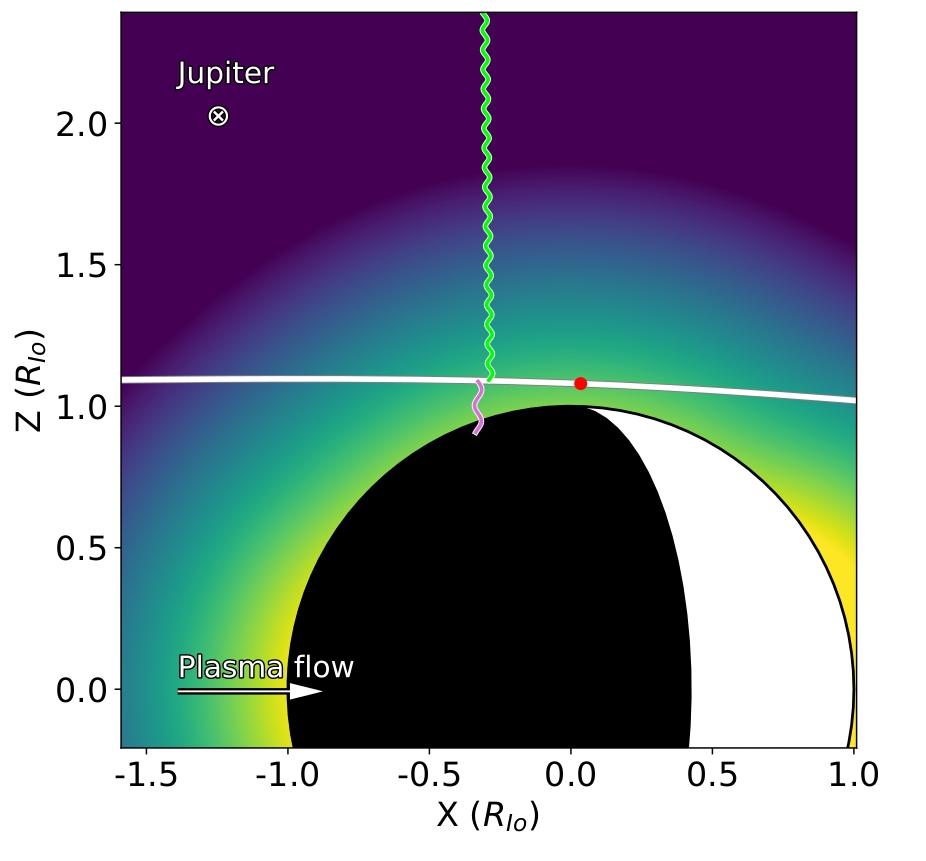
See publication for further information:
, , , , , & (2024). Energetic proton losses reveal Io's extended and longitudinally asymmetrical atmosphere. Journal of Geophysical Research: Space Physics, 129, e2023JA032371. https://doi.org/10.1029/2023JA032371
Plasma observations in the high-latitude and distant magnetotail associated with cusp-aligned arcs during intervals of northward IMF
By Michaela Mooney and Steve Milan (University of Leicester)
During periods of northward interplanetary magnetic field (IMF), the magnetospheric structure and dynamics are dramatically different and less understood compared to the southward IMF case.
Under northward IMF magnetic reconnection occurs at higher latitudes tailward of the cusp, known as lobe reconnection (Dungey, 1963). Lobe reconnection can occur on the same IMF field line in both hemispheres, known as dual lobe reconnection. It is thought that dual lobe reconnection can result in either the partial or complete closure of the magnetosphere (Milan et al., 2022). The auroral oval is also contracted to higher latitudes reflecting the reduced open flux content of the magnetosphere. The auroral emission is dimmer and distinct auroral features are observed poleward of the auroral oval such as cusp-aligned arcs, horse collar aurora and transpolar arcs.
Using Cluster and ARTEMIS in-situ data, we examined a period of prolonged northward IMF during which multiple instances of cusp-aligned arcs were observed poleward of the auroral oval. The Cluster observations showed trapped plasma on closed flux in the high latitude magnetotail (|ZGSE| ~ 13 RE) in regions which would typically be expected to be open magnetotail lobe void of plasma under southward IMF. Meanwhile, the ARTEMIS spacecraft observed simultaneous high electron and ion fluxes in the distant magnetotail (XGSE ~ - 60 RE). The plasma in both magnetotail regions was observed coincidently with observations of cusp-aligned arcs in the auroral data. We interpret these observations of trapped plasma on closed field lines as providing the source population for the cusp-aligned arc emission in the polar region.
During this interval we suggest that the magnetosphere was almost entirely closed as a result of dual lobe reconnection. The magnetotail is closed or partially closed but extends at least as far as ∼ 60 RE downtail. The occurrence of plasma in the magnetotail and the closure of the magnetosphere resulted in distinct changes to the magnetotail structure including a reduction in the magnetic field strength and pressure as well as a narrowing of the tail by approximately 20 RE.
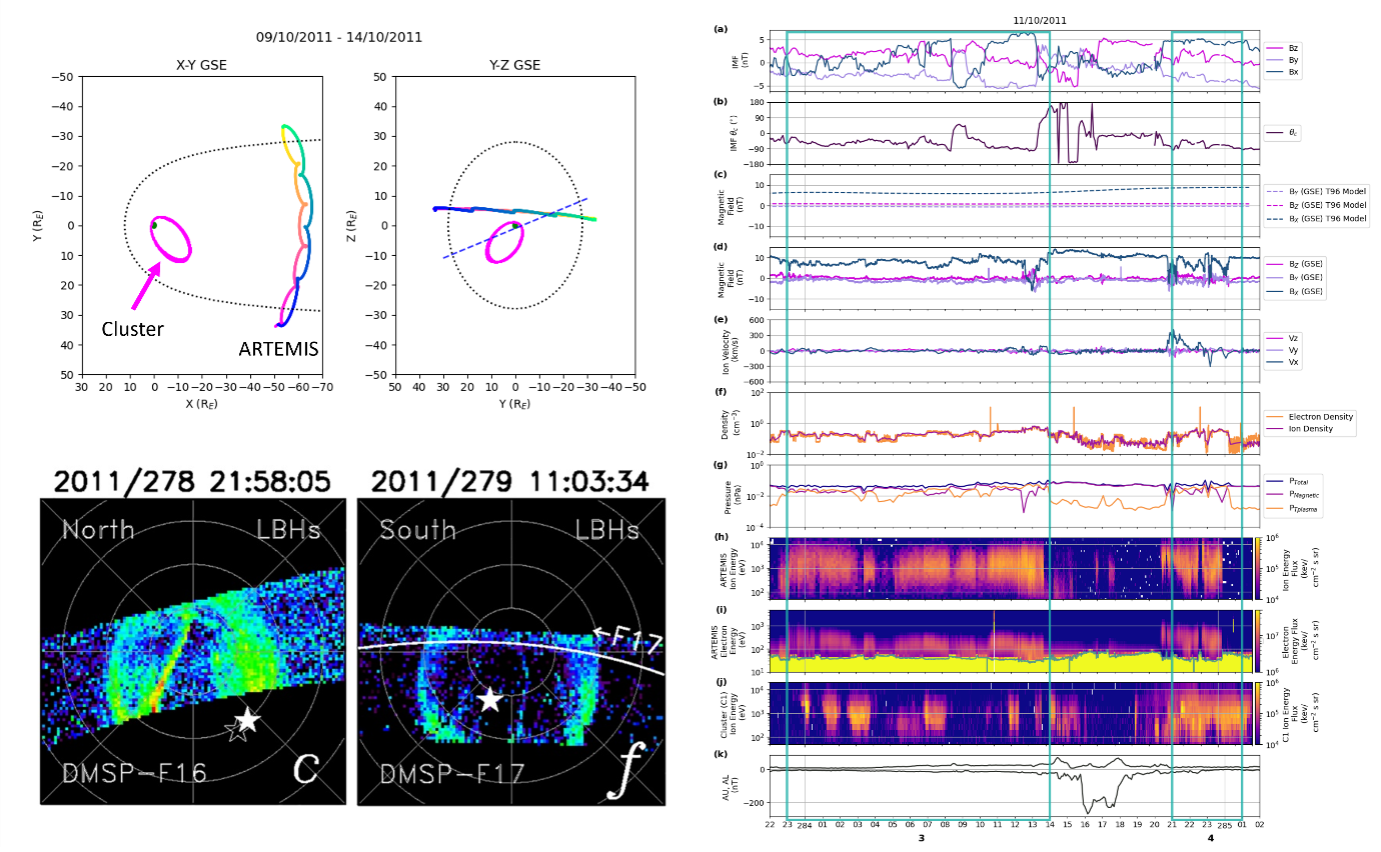
See the full papers for further details:
Milan, S. E., Mooney, M. K., Bower, G. E., Taylor, M. G. G. T., Paxton, L. J., Dandouras, I., et al. (2023). The association of cusp-aligned arcs with plasma in the magnetotail implies a closed magnetosphere. Journal of Geophysical Research: Space Physics, 128, e2023JA031419. https://doi. org/10.1029/2023JA031419
Mooney, M. K., Milan, S. E., & Bower, G.E. (2024). Plasma observations in the distant magnetotail during intervals of northward IMF. Journal of Geophysical Research: Space Physics, 129,e2023JA031999. https://doi.org/10.1029/2023JA031999
Validating GIC models in the UK using Differential Magnetometer and Magnetotelluric Data
By Juliane Huebert (British Geological Survey)
Geomagnetically induced currents (GICs) are a well-known consequence of increased geomagnetic activity due to solar storms. They pose the risk of damaging ground-based infrastructure like the high voltage power transmission network, gas pipelines and railways. Large-scale models of GICs in the UK exist, taking into account geomagnetic data, the induced ground electric fields and the configuration of the ground-based technologies. Validating these complex models is not easy and requires independent observations. To measure GICs in the HV voltage power network, we applied the Differential Magnetometer Method (DMM) at several sites in Britain. At each site, one magnetometer was placed under the power lines while a second one was located a few hundred meters away. By looking at the difference in the data between the two we can isolate the direct current flowing in the power lines. Data were recorded for several months, catching periods of increased geomagnetic activity. We then compared the measured current strength to the BGS GIC model developed from open source data sets of the UK power grid. The model also uses a measure for the ground electrical conductivity that is based on so-called magnetotelluric (MT) measurements which we performed in a country-wide campaign. MT data is necessary to characterize the spatial changes in the ground electric field due to local geology. We found our model and the field measurements to match very well, giving confidence that our simulations of the whole UK grid are very close to the correct values.
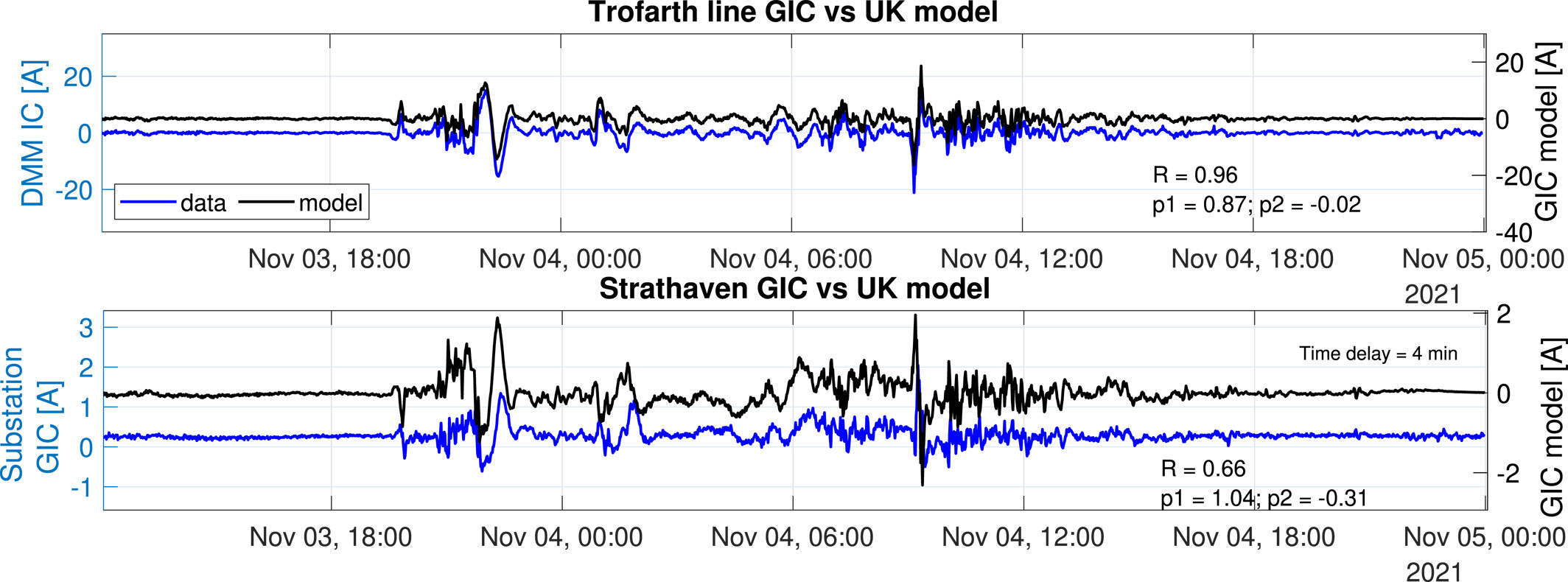
See full paper for further details:
Hübert, J., Beggan, C. D., Richardson, G. S., Gomez-Perez, N., Collins, A., & Thomson, A. W. P. (2024). Validating a UK geomagnetically induced current model using differential magnetometer measurements. Space Weather, 22, e2023SW003769. https://doi.org/10.1029/2023SW003769
Orbyts Impact Report
By Jasmine Sandhu (University of Leicester)
Orbyts is a multi-award winning movement that partners scientists with schools to empower school students to undertake world-leading research. In this MIST nugget, we are delighted to present Orbyts very first Impact Report!
Read the Orbyts Impact Report 2017-2023 here: https://www.orbyts.org/impact
Over the past six years we have seen the programme enable a transformational impact on young people, researchers and teachers alike and we’re excited to share that with you here.
To date, Orbyts has created 100+ research partnerships, empowering 1500+ school students. We’ve increased inclusivity in post-16 STEM uptake, where students Orbyts engaged are 50+% girls, 50+% pupil premium, and identified from 48+ ethnicities. We have grown with new Hubs in North East England and Leicester, alongside expansion of our London Hub.
Read the report for all the statistics on Orbyts, spotlights on the ground-breaking research being led by students, and all the exciting plans for Orbyts in 2024!
We’d like to extend our thanks to all those who have and continue to support Orbyts, without whom this work would not be possible. In particular we would like to thank all the researchers and teachers for all their time and hard work. We also gratefully acknowledge support from all of our funders, including the UCL Access and Widening Participation Office, the Ogden Trust, UK Space Agency, European Research Council, EPSRC, and STFC.
Orbyts currently sits precariously positioned with no financial support beyond our upcoming 2024 programme. If you think that Orbyts might be something you would like to support, then we would love to hear from you at This email address is being protected from spambots. You need JavaScript enabled to view it..
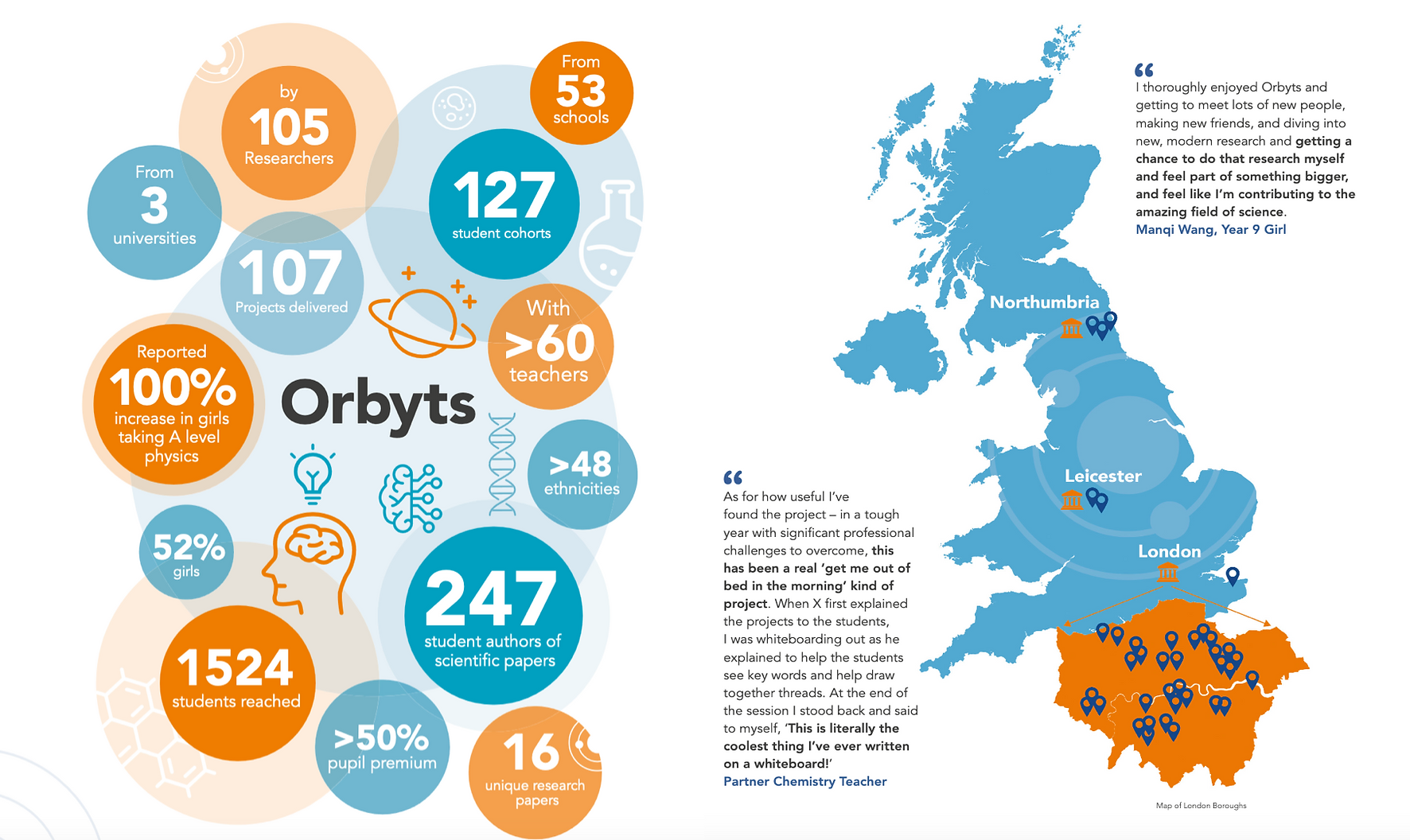
Read the Orbyts Impact Report 2017-2023 for further details: https://www.orbyts.org/impact.
Surface Charging of Jupiter's Moon Europa
By Sachin Reddy (UCL / National Institute of Polar Research)
Jupiter’s moon Europa is exposed to a constant flow of plasma from its own ionosphere and the Jovian magnetosphere, which consists of a thermal and suprathermal population. As these particles flow onto the surface, an electrostatic potential forms in accordance with Kirchhoff’s current law. In this study, we investigate the electric charging of Europa’s icy surface using 3D particle-in-cell simulations via the Spacecraft Plasma Interactions Software (SPIS).
We find that surface potentials on Europa vary from -14 to -52 V. They change as a function of Europa’s four hemispheres, the solar illumination conditions, the plasma environment, and the properties of the surface itself. We reveal that the presence of an ionospheric plasma population reduces the surface potentials, producing a “dampening effect”. We also find that secondary electron emission is a crucial mechanism in Europan charging, shifting potentials by an order of magnitude for the same plasma properties. We argue that additional laboratory work into Europa-like-ice electron emission is necessary to reduce the uncertainties in the modelling. These results could be both corroborated and improved upon by the upcoming Europa Clipper and JUICE missions, and may be of use in the design of future missions to Europa’s surface (e.g. landers or other robotic explorers).
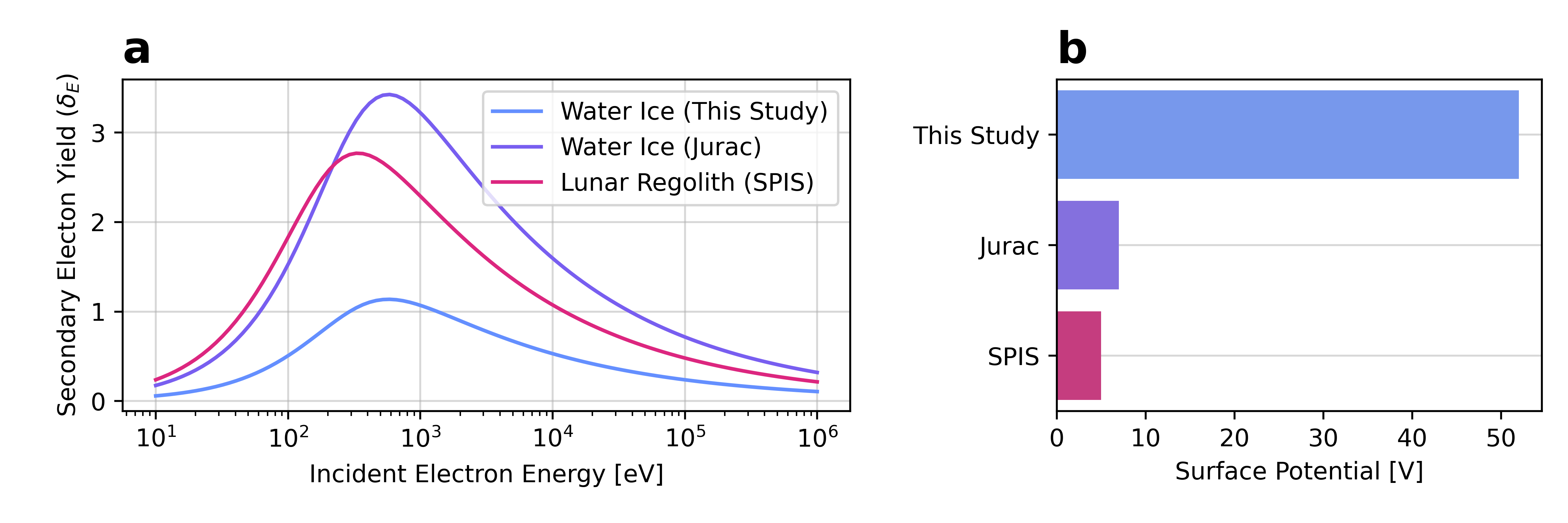
See full paper for further details:
Reddy, Sachin A., Nordheim, Tom N. and Harris, Camilla, D.K.,. "Surface Charging of Jupiter’s Moon Europa." The Astrophysical Journal Letters 962.2 (2024): L29. https://doi.org/10.3847/2041-8213/ad251e